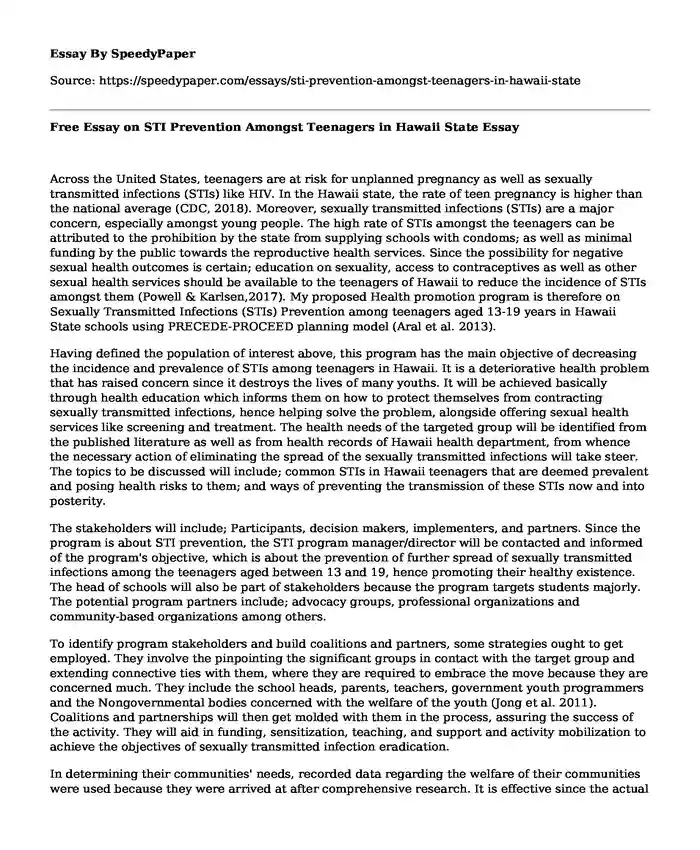
| Type of paper: | Essay |
| Categories: | HIV Human sexuality |
| Pages: | 3 |
| Wordcount: | 616 words |
Across the United States, teenagers are at risk for unplanned pregnancy as well as sexually transmitted infections (STIs) like HIV. In the Hawaii state, the rate of teen pregnancy is higher than the national average (CDC, 2018). Moreover, sexually transmitted infections (STIs) are a major concern, especially amongst young people. The high rate of STIs amongst the teenagers can be attributed to the prohibition by the state from supplying schools with condoms; as well as minimal funding by the public towards the reproductive health services. Since the possibility for negative sexual health outcomes is certain; education on sexuality, access to contraceptives as well as other sexual health services should be available to the teenagers of Hawaii to reduce the incidence of STIs amongst them (Powell & Karlsen,2017). My proposed Health promotion program is therefore on Sexually Transmitted Infections (STIs) Prevention among teenagers aged 13-19 years in Hawaii State schools using PRECEDE-PROCEED planning model (Aral et al. 2013).
Having defined the population of interest above, this program has the main objective of decreasing the incidence and prevalence of STIs among teenagers in Hawaii. It is a deteriorative health problem that has raised concern since it destroys the lives of many youths. It will be achieved basically through health education which informs them on how to protect themselves from contracting sexually transmitted infections, hence helping solve the problem, alongside offering sexual health services like screening and treatment. The health needs of the targeted group will be identified from the published literature as well as from health records of Hawaii health department, from whence the necessary action of eliminating the spread of the sexually transmitted infections will take steer. The topics to be discussed will include; common STIs in Hawaii teenagers that are deemed prevalent and posing health risks to them; and ways of preventing the transmission of these STIs now and into posterity.
The stakeholders will include; Participants, decision makers, implementers, and partners. Since the program is about STI prevention, the STI program manager/director will be contacted and informed of the program's objective, which is about the prevention of further spread of sexually transmitted infections among the teenagers aged between 13 and 19, hence promoting their healthy existence. The head of schools will also be part of stakeholders because the program targets students majorly. The potential program partners include; advocacy groups, professional organizations and community-based organizations among others.
To identify program stakeholders and build coalitions and partners, some strategies ought to get employed. They involve the pinpointing the significant groups in contact with the target group and extending connective ties with them, where they are required to embrace the move because they are concerned much. They include the school heads, parents, teachers, government youth programmers and the Nongovernmental bodies concerned with the welfare of the youth (Jong et al. 2011). Coalitions and partnerships will then get molded with them in the process, assuring the success of the activity. They will aid in funding, sensitization, teaching, and support and activity mobilization to achieve the objectives of sexually transmitted infection eradication.
In determining their communities' needs, recorded data regarding the welfare of their communities were used because they were arrived at after comprehensive research. It is effective since the actual information on the target group is precisely gathered, detailing on how the teenage target group was to get handed to benefit from the program, as well as the social requirements and inclinations regarding the activity at hand. They are more promising and circumspection.
References
Aral, S. O., Fenton, K. A., & Lipshutz, J. A. (2013). The new public health and STD/HIV prevention: Personal, public, and health systems approach. New York: Springer.
Jong, E. C., & Stevens, D. L. (2011). Netter's Infectious Diseases E-Book.
Cite this page
Free Essay on STI Prevention Amongst Teenagers in Hawaii State. (2022, Jun 29). Retrieved from https://speedypaper.com/essays/sti-prevention-amongst-teenagers-in-hawaii-state
Request Removal
If you are the original author of this essay and no longer wish to have it published on the SpeedyPaper website, please click below to request its removal:
- Education Essay Sample: Hardships Faced in the College Journey
- Essay Sample about Intergenerational Poverty
- Free Essay on Efficacy of Self-administered Interview
- Research Analysis Essay Sample: End-of-life Decision-Making in Nursing
- Liquidity of Inventory Essay Sample
- Paper Example. Safe Harbor Agreement
- One Hour of Activity: Enhance Your Heart Health - Essay Sample
Popular categories




